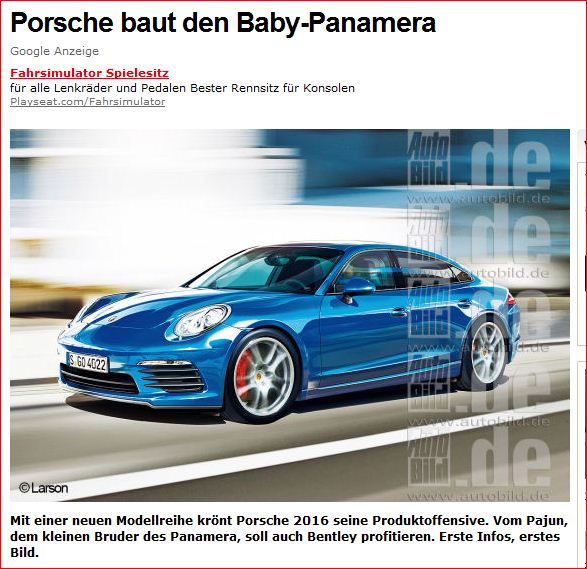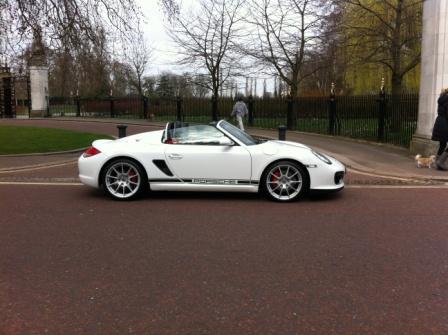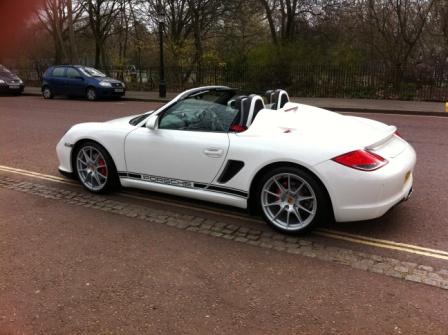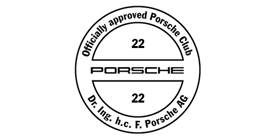ORIGINAL: dereksharpuk
Aaaah. is that a Boxster Spider I see before me? [

]
Did you not read EVO last year when it compared a new Boxster Spider against a secondhand 360 Spider (both £50K). In summary, the Porsche did everything so much better, more economical, better handling and more reliable. Actually, heaps more reliable [

] However, they chose the Ferrari!
I missed that article but I am sure the reasons they may have given for going with the Italian wouldn't have persuaded me to do the same  I have had 11 Porsches in 3 decades and the reasons for my buying the first 911 way back when [
I have had 11 Porsches in 3 decades and the reasons for my buying the first 911 way back when [ ] have only been strengthened over all these years even though owning one today is no longer as cost effective [
] have only been strengthened over all these years even though owning one today is no longer as cost effective [ ]
]
13. For the superstitious, it's not a number that suggests good luck. Neither does "Porsche" plus "Spyder" plus "Central California." Even so, thirteen 2011 Box¬ster Spyders have been flown into the Golden State from Ger¬many. We see the location of the press launch as lucky: It's two hours from home and, even better, it offers superb sports-car roads we know intimately.
Twelve of the German-spec Spy¬ders are in Carmel Valley, the other is at the L.A. Auto Show. That Porsche sees this as an important debut is clear, as Super¬visory Board Member Klaus Bern¬ing is present. Car people seem to agree; the Spyder gets a rousing reception in the City of Angels. Apparently, the world could use a little blue sky just now, and a back-to-basics Porsche less concerned with sheltering its occupants than opening the world to them is on target.
Even the hardcore approve. GT2 and GT3 web forums are raving about a Box¬ster in 10+page threads. It's not idle chatter: A friend of mine has sold his 997 GT3, trading it on a Spyder. Another, with 997 GT3 RS and 993 keepers, passed on his dealer's first 2010 RS for its first Spyder.
Clearly, Porsche has a struck a nerve. In truth, says David Pryor, PCNA's Vice President for Mar¬keting, the Spyder's timing is pure luck. It got its start in 2007, when U.S. product planning asked for a stripped-down Box¬ster S"ˆand Cayman S. The former got the nod, and became the car you see here. Given the new Spy-der's instant popularity in L.A., we suspect that a similar Cay¬man is on the way. But it will be hard-pressed to match the soft-top Spy¬der's 176-pound weight savings.
Question is, can the Spyder be much better than the already superb Box¬ster S it's based on? Or is it a marketing ploy, a car to generate foot traffic in dealerships? First press photos had us thinking the latter. The tent-like top. The humpy decklid. No radio, no A/C, no foglights, and no cupholders "” for more money, not less.
Then other, promising details came clear: aluminum doors and lids, limited-slip diff, ultralight 19-inch wheels, -20-mm sport suspension, and lightweight bucket seats, all standard. Best of all, 176 fewer pounds are pushed by 10 more horses, for a total of 320. But still. That top!
Then we see the car in Carmel. Silver Box¬sters may be a bit boring these days, but the silver Spyder in front of Ben Pon's Bernar¬dus Lodge isn't. Arctic Silver makes the Spyder look metal where white leaves it looking a bit plasticky. Standing next to it, viewing the car as you normally would, its trunklid is a stunner. The alloy humps tie things together, subtly mirroring the diffuser while giving the fussy lower curves of the 987-2's dip-down taillights more to work with than fender tops alone.
The humps elevate the Boxster. Por¬sche people see shades of Carrera GT. People on the street aren't quite sure what they're looking at, but they know it's something special. Had the too-long trunk text been shortened to "Spy¬der," they'd probably still be guessing. There's something exotic about this 987, moving it away from the mental slot marked "just another Boxster" and closer to the one reserved for "Spider, 360/F430."
The distinction continues up front. The bumper is the same, but its outer intakes get titanium-colored surrounds and one vane instead of two. Cayman LED strips sit in plain housings. There are no foglights, and plain black spoiler lips harden the nose. Down the sides, 1960s Por¬sche scripts lead the eye to plain mesh intakes with titanium-colored surrounds.
Inside, folding sport bucket seats trim weight. Fabric-loop door releases from the GT3 RS recall those in RSs 964 and 993. Their fabric matches the seatbelts (red or black depending on interior color), their plastic housings mounted by a single exposed screw. They look a bit cheap, but so did the Fiat pulls that Porsche's Sport Purposes department used in the 1970s. A gimmick? No. Engineers say each shaves 2.2 pounds in a good spot.
The gauges still wear too-cute Boxster fonts, but their faces are all-business black rather than silver and their hood is gone. In place of the missing cupholder's multi-piece door is a plastic strip that, like the other dash trim strips, is body color. The center console between the seats is, too, and the plastic doorsill finishers have been re¬placed by model name stickers.
The top says it all, though. To all who see the Spyder, be they car nuts or tree huggers or both, it screams "minimalist!" and backs it up by weighing 12 pounds. Inside, a stamped-steel claw fastens a carbon-fiber front top bow that's nice but not overly polished. The two-piece top stows over the engine, fitting in a black styrofoam receptacle accessed by opening the huge, one-piece decklid. No gas struts help you lift the latter, and you prop it up with an aluminum stick, RS-style. The lid is only heavy if you discount its size, and swings on decidedly unproduction-like aluminum hinges under the humps.
Any nagging thoughts that the Spyder is a parts-bin exercise fade as I speak to Maurice van de Weerd. Fairly new to Por¬sche, he's the suspension man be¬hind VW's brilliant Mk. V GTI, a car hailed as the return of the proper GTI. One would suspect he had more fun starting with a mid-engined car. He's quick to say that he had help from another Weissach engineer "” one he considers a friend and one who works on GT2s and GT3s.
The Spyder sits 20 mm lower than a Boxster S and 10 mm lower than a PASM-equipped one "” but not on mere lowering springs with mildly increased rates. "Compared to the standard Boxster S, we increased the stiffness front and rear," says van de Weerd. "In front, by ten percent and in the rear by 30 percent. We changed the spring balance significantly, so we have different body motions. The front anti-roll bar is a little stiffer, the rear is the same." So were the dampers simply retuned to match the new spring rates?
"No, it's more than that," he says. "The philosophy behind the damper tuning is new and that's due to the extreme focus on driving fun and performance aspects. And because the car is lighter with lighter wheels, we had more freedom to find another compromise between comfort and the performance side "” it helped me as a chassis guy to fulfill this compromise. We changed the damper forces quite significantly, reducing the rebound side and increasing the compression."
Since the Spyder is lighter, the revised spring rates are effectively even higher. Van de Weerd says no bushings were changed, but camber settings have been altered. Asked why electronically variable PASM dampers aren't available, he gives two reasons: "First, we wanted to make more of a purist's car, one without, as much as possible, electronics. So it was decided to get the maximum puristic performance and fun-to-drive with conventional dampers. Then, if you look at overall production, it doesn't make sense to make an optional suspension available. The amount of cars is just too low."
Low and light suits us. Leav¬ing sleepy, one-story downtown Car¬mel Valley, the Spyder's rear end is a bit bouncy as it rolls over mild bumps at 25 mph. It's never brittle, though. There are no sharp shocks; each imperfection's edge is edited into something you no¬tice rather than something you're annoyed by.
The road out of town leads right then left, feeding into more rights and lefts as it trades buildings for mysterious driveways and, eventually, raw California. The 3.4-liter flat six is a match for the Cayman S's 320-hp unit thanks to electronic tuning. The ten horses over a Box¬ster S isn't noticeable, but the exhaust note from the optional sport exhaust is. When engaged, there's more than enough noise from the twin tips.
In thrust, this 3.4 doesn't disappoint. Peak torque of 273 lb-ft arrives at 4750 rpm, with 200 lb-ft available by 2000 rpm. Second-gear grunt off turns is strong, the shove of torque giving way to the elastic pull of horsepower as the 3.4 hits 6000 rpm and sprints for its redline at 7500. After a shift to third, speed keeps piling on. This is a genuinely fast car, one that's deeply satisfying to use on a back road with the six-speed manual.
The latter has you feeling connected in a car you want to be connected to. 176 pounds lighter? It feels like the engineers shaved even more. The weight saved, lower roll center, and sport suspension add up to a sharpness no factory Box¬ster can match. In fact, the clarity of this chassis' signals are at least a match for the best we've experienced in any road-going Por¬sche. Everything feels connected. Small inputs to the steering wheel or pedals are noted and translated to the tires. Under¬steer has been all but eliminated. The car turns in quickly, its rear end feeling ready to rotate in a confidence-inspiring way rather than a scary one.
Soon, it's one of those drives where car, driver, and road meld. Movements in¬side the cockpit are minute as pavement, pasture, and sky stream. As the Spy¬der decimates the sinuous blacktop, I wonder: Do you really need more sports car? That's because the Spyder is serving up the best drive I've had in a new Porsche in years.
"Who needs a 911?!?" shouts my passenger suddenly, as if he hears me. While I know no mid-engined car can offer the experience of a rear-engined one, we're clearly thinking along similar lines. As first tastes go, it's as good as a Porsche press launch gets. After another hour or two, it's time to return the Spyder. Reluctantly.
We're feeling lucky as we head for home. All 13 Spyders must go back to Europe, but PCNA's Dave Engelman has asked if we might make use of one for a few days. After all, the cars are in our neighborhood"¦
One of the silver Spyders that caused us to catch our breath in Carmel arrives not long after, this one with standard brakes. Under darkening skies, we hatch a plan: Weigh the car, drive it to a dinner two hours away, test it on track, and run it on our Secret Test Loop, where we have tested every new Porsche since 1997.
The Spyder rolls onto S Car Go Rac¬ing's scales in nearby San Rafael with a full tank of gas. Loaded with A/C ($1,760), PCM ($3,110), Carrera Red full leather ($3,895), and the sport exhaust ($2,500), it weighs in at 2,958 pounds with its 12-pound top on board. That's 147 higher than the 2,811 listed on the spec sheet, 29 less than the listed weight of a Boxster S. While we suspect options account for at least half of the difference, it's the first new Porsche under 3,000 pounds since the 986 (the last one we weighed, a 1999 car, came in at 2,917 with half a tank).
Meanwhile, gray skies are shaping up nicely. As we roll off the scales, a cold December day turns rainy. More luck: It's a perfect chance to test the two-piece top in real weather. Since Mrs. Stout has no idea she's about to partake in the test, I decide to check things out in light rain before committing her to a 200-mile soaking. On the recon run, sealing at the windshield proves every bit as good as in a normal Boxster. More surprising is the way water streams along the side windows. Rather than spraying in where the top covers but doesn't seal against each pane's upper edge, the stream traces the upper arc but stays an inch below it and dribbles down the trailing edge. Clever.
In heavier rain that night, a few drops quiver on small plastic trim plates behind each door while pin-prick drops dust the roll-bar trims. But not one drop hits us in strong, steady rain at speeds of up to 90, or in Midwest-like rain hard enough to slow us to 45 mph. There are caveats.
The top must be put on perfectly. During after-dinner demonstrations of this Erector Set "” with practice, it takes us 1:35 to stow it, 2:30 to erect it "” a friend wants to help. When we leave, rain gets in. On my better half. Noth¬ing looks amiss, but redoing the top in a gas station fixes the problem.
With the top installed correctly, there's a bit more wind-noise than in a standard Box¬ster "” but you can still hold a normal conversation. The only draft comes if you reach a hand up to the top of the Spyder's squat side windows. Solu¬tion: Don't.
Four other notes: 1) To avoid stretching the top, a maximum of 125 mph with it up is suggested "” and it isn't pleasant past 100; 2) Top down, with windblocker in place, airflow management is superb; 3) That small rear window is just fine; 4) Overall, the top is good enough that we'd consider a Spyder as a daily car. Yes, its single layer is vulnerable to slashers and you can stick a finger in above the side windows if you try "” but we suspect few passersby will spot these vulnerabilities.
Enough with the top, though. A one-day break in the rain happens to coincide with a Hooked on Driving track day at Laguna Seca. I buy a lottery ticket, then load up the Spyder and Project Cayman S. While I'll leave all-out lap times to local SCCA champ David Ray (see sidebar), I spend a couple of sessions in each 987.
My takeaways? The Cay¬man S feels more appropriate, more focused on track, mostly due to its closed cockpit. That and its dual-clutch PDK gearbox encourage me to drive it harder. Even so, the Spyder is the sharper car, with noticeably less understeer and purer responses from its lower, non-PASM suspension.
As for differences in torsional rigidity, they simply don't stand out on track. But, on rougher sections of our Secret Test Loop, they do. Moving between Spyder and Cayman S, the latter has a noticeably stiffer frame. That said, any lack of rigidity is only brought to light by the Cayman; on its own, the Spyder's platform feels fine. More importantly, its suspension works better here. While the Cayman's 18s and PASM filter out more, the Spyder is supple enough while delivering superior feedback, predictability, and turn-in.
Along the Loop's endless switchbacks, the open 987 comes into its own. Its transient re¬sponses are quicker than any I've experienced in a factory street car. It has a directness every sports car aspires to but few achieve. For trackwork, the Cay¬man Sis still the 987 to have. On the Loop, we prefer the Spy¬der. For $300 less, you get more desirable pieces in a car that, as a sum, feels noticeably more special.
Is it a match for the latest greats, GT2 and GT3? As an experience, yes. While its 3.4-liter 9A1 six doesn't feel or sound exotic enough to justify a GT badge, the rest of this 987 is cut from the same cloth. Yet it is different: Where price alone renders the six-figure GT3 and GT2 rare, the Spy¬der is and always will be separated by that which defines it: its minimalist top.
In time, that top won us over. For the interaction in using it. For making you feel like you're getting away with something in the rain. For the way it looks when it's up. And for the way it will discourage those with a lesser commitment to the one thing that makes a sports car truly great: purity.
Is the Spyder perfect? Not quite. We'd like a lustier flat six "” and the car is so sharp it left us wishing for things to further sharpen the experience, like more in¬take noise, a light flywheel, shorter shift throws, and ceramic-composite brakes. The latter can be had for $8,150, but don't order them to save weight; the much-larger-in-this-case PCCBs shave just 6.6 pounds.
Fortunately, the standard car is superb and recalls the greatest Porsche in more than merely visual terms. Like the Carrera GT, it manages that rare feat of being an open car without feeling like a soft choice. Like the C-GT, its handling defines just how good a mid-engine road car can be "” but this time at a far more affordable, far more approachable level.
It's a Por¬sche for drivers, big skies, and the senses. But for its merely great flat six, it's a full display of Weis¬sach's genius. Yes, the Spyder is insanely good, but the fact that it is Porsche's best new car on the Loop in years isn't dumb luck.













